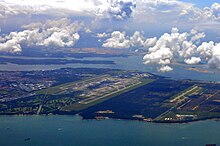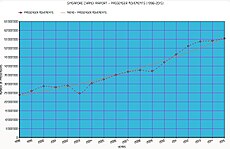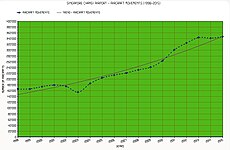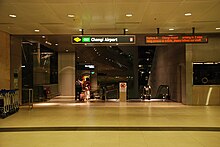Changi Airport: Difference between revisions
Andrewgprout (talk | contribs) |
No edit summary |
||
| Line 212: | Line 212: | ||
| [[Jetstar Airways]]|[[Ngurah Rai International Airport|Denpasar]], [[Melbourne Airport|Melbourne]], [[Perth Airport|Perth]] | 1 |
| [[Jetstar Airways]]|[[Ngurah Rai International Airport|Denpasar]], [[Melbourne Airport|Melbourne]], [[Perth Airport|Perth]] | 1 |
||
<!-- --> |
<!-- --> |
||
| [[Jetstar Asia Airways]]|[[Suvarnabhumi Airport|Bangkok–Suvarnabhumi]], [[Da Nang International Airport|Da Nang]], [[Darwin International Airport|Darwin]], [[Ngurah Rai International Airport|Denpasar |
| [[Jetstar Asia Airways]]|[[Suvarnabhumi Airport|Bangkok–Suvarnabhumi]], [[Da Nang International Airport|Da Nang]], [[Darwin International Airport|Darwin]], [[Ngurah Rai International Airport|Denpasar]], [[Guiyang Longdongbao International Airport|Guiyang]], [[Haikou Meilan International Airport|Haikou]], [[Hangzhou Xiaoshan International Airport|Hangzhou]], [[Tan Son Nhat International Airport|Ho Chi Minh City]], [[Hong Kong International Airport|Hong Kong]], [[Soekarno-Hatta International Airport|Jakarta–Soekarno Hatta]], [[Kuala Lumpur International Airport|Kuala Lumpur–International]], [[Ninoy Aquino International Airport|Manila]], [[Kuala Namu International Airport|Medan]], [[Kansai International Airport|Osaka–Kansai]], [[Sultan Mahmud Badaruddin II International Airport|Palembang]], [[Sultan Syarif Kasim II International Airport|Pekanbaru]], [[Penang International Airport|Penang]], [[Perth Airport|Perth]], [[Phnom Penh International Airport|Phnom Penh]], [[Phuket International Airport|Phuket]], [[Sanya Phoenix International Airport|Sanya]],<ref>{{cite web|title=Jetstar Asia to commence brand new service from Singapore to sunny Sanya|url=http://newsroom.jetstar.com/jetstar-asia-to-commence-brand-new-service-from-singapore-to-sunny-sanya/}}</ref> [[Jieyang Chaoshan International Airport|Shantou]], [[Siem Reap International Airport|Siem Reap]], [[Juanda International Airport|Surabaya]], [[Taiwan Taoyuan International Airport|Taipei–Taoyuan]], [[Yangon International Airport|Yangon]] | 1 |
||
<!--+--> |
<!--+--> |
||
| [[Jetstar Pacific Airlines]]|[[Tan Son Nhat International Airport|Ho Chi Minh City]] | 1 |
| [[Jetstar Pacific Airlines]]|[[Tan Son Nhat International Airport|Ho Chi Minh City]] | 1 |
||
Revision as of 18:32, 1 October 2016
Singapore Changi Airport Lapangan Terbang Changi Singapura 新加坡樟宜机场 (Xīnjiāpō Zhāngyí Jīchǎng) சிங்கப்பூர் சாங்கி சர்வதேச விமானநிலையம் (Ciṅkappūr Cāṅki Vimana Nilaiyam) | |||||||||||||||||||
|---|---|---|---|---|---|---|---|---|---|---|---|---|---|---|---|---|---|---|---|
| File:Singapore Changi Airport logo.svg | |||||||||||||||||||
 | |||||||||||||||||||
| Summary | |||||||||||||||||||
| Airport type | Public / Military | ||||||||||||||||||
| Owner | Government of Singapore[1] | ||||||||||||||||||
| Operator | |||||||||||||||||||
| Serves | Singapore | ||||||||||||||||||
| Location | Changi, Singapore | ||||||||||||||||||
| Opened | 1 July 1981 (operational) 29 December 1981 (official) | ||||||||||||||||||
| Hub for | |||||||||||||||||||
| Time zone | SST (UTC+08:00) | ||||||||||||||||||
| Elevation AMSL | 6.66 m / 22 ft | ||||||||||||||||||
| Website | www | ||||||||||||||||||
| Map | |||||||||||||||||||
| Runways | |||||||||||||||||||
| |||||||||||||||||||
| Statistics (2015) | |||||||||||||||||||
| |||||||||||||||||||
Source: Changi Airport Group [3] | |||||||||||||||||||
Singapore Changi Airport (IATA: SIN, ICAO: WSSS), or simply Changi Airport, is the primary civilian airport for Singapore, and one of the largest transportation hubs in Southeast Asia. It is currently the World's Best Airport (Skytrax 2016),[4] for the fourth consecutive year and counting (Skytrax's World's Best Airport 2013-2016) and is one of the world's busiest airports by international passenger traffic and cargo traffic. The airport is located in Changi, at the eastern end of Singapore, approximately 17.2 kilometres (10.7 mi) northeast[5] from Marina Bay (in Singapore's Downtown Core), on a 13-square-kilometre (5.0 sq mi) site. It is operated by Changi Airport Group and it is the home base of Singapore Airlines, Singapore Airlines Cargo, SilkAir, Scoot, Tigerair, Jetstar Asia Airways and BOC Aviation.
Overview of Changi Airport
Changi Airport serves more than 100 airlines flying to some 320 cities in about 80 countries and territories worldwide. Each week, about 6,800 flights land or depart from Changi, or about one every 90 seconds, with 55.4 million passengers passing through the airport in 2015.[3]
For the 2015 full-year figures published by the airport, the airport handled 55,448,964 passengers (a 2.5% increase over the previous year), the most in its 34-year history. This made it the seventh busiest airport by international passenger traffic in the world and the second busiest in Asia by international passenger traffic in 2015. In December 2015, Changi Airport registered a total of 5.29 million passenger movements, the highest ever traffic the airport has achieved in a month since it opened in 1981. Its daily record was also broken on the Saturday before Christmas (19 December 2015), with more than 192,000 passengers passing through during the 24 hours. In addition to being an important passenger hub, the airport is one of the busiest cargo airports in the world, handling 1.85 million tonnes of cargo in 2015. The total number of commercial aircraft movements increased by 1.4% from the previous year to 346,334 in 2015.[3]
The airport has won over 500 awards since 1981, including 28 "Best Airport" awards in just 2015 alone.[6] Changi Airport's efforts to mitigate the effects of ageing infrastructure include continual physical upgrades to its existing terminals and building new facilities to maintain its reputation for setting standards in airport service quality.[7]
Passenger Terminals
Changi Airport has three main passenger terminals, arranged in an elongated inverted 'U' shape. Currently the airport has a designed total annual handling capacity of 66 million passengers.
- Terminal 1 opened in 1981, located at the northern end.
- Terminal 2 in 1990, located to the eastern side.
- Terminal 3 in 2008, located to the western side.
There is also a privately run luxury terminal called the JetQuay CIP Terminal. It is similar to the Lufthansa First Class Terminal at Frankfurt Airport, but is open to all passengers travelling in all classes on all airlines but with an access fee.
Former Terminal
The Budget Terminal, opened on 26 March 2006 and closed on 25 September 2012.
Future Terminals
- Terminal 4, which will be ready by 2017, built on the site of the former Budget Terminal.[8]
- Terminal 5 is set to be ready in the mid-2020s. It will be able to handle 50 million passenger movements per annum.[9] The airport terminal structure will almost be larger than all the previous terminals combined, built on reclaimed land to the east of the present terminals.
- Jewel Changi Airport set to open in 2019, is a multi-use structure interconnecting Terminals 1, 2 & 3. Part of the project will help expand Terminal 1 to handle 28 million passengers per year.
Operations



Passenger operations
As all passenger traffic out of the airport is international in nature, the three major terminals in operation are equipped with immigration-processing facilities for international travel.
After recovering from a drop in passenger traffic as a result of the September 11 attacks in 2001, the severe acute respiratory syndrome (SARS) epidemic in 2003, the airport saw rapid growth in traffic, which hit the 30-million mark for the first time a year later in 2004. In March 2008 and prior to the full effect of the financial crisis of 2007–2010 on the global economy, the airport predicted that it will handle 50 million passengers by 2012,[10] with increases due to the opening of casinos in Singapore, together with the phased liberalisation of the Asean aviation sector. As predicted, the airport surpassed the 50-million mark for the first time in history in 2012.[7]
Cargo operations
The Air Cargo Division of the Changi Airport Group manages the Changi Airfreight Centre[11] located in the north of the airport premises.[12] The airport handled 1.81 million tonnes of air cargo in 2012, making it the 7th-busiest airfreight hub in the world and the fifth-busiest in Asia.[13] Due to Singapore's large electronics sector, electrical components constitute a significant part of the total cargo traffic handled at the airport, although it has initiated attempts to diversify into the perishable air cargo market.
In 2015, Changi Airport handled 1,853,087 tonnes of air freight, which is more than the total combined weight of four Burj Khalifa skyscrapers.
Air Cargo World awarded Changi Airport the 2013 Air Cargo Excellence Award for airports handling more than 1,000,000 tonnes of cargo in Asia.[14]
Key markets
In 2015, Indonesia was the largest market for Singapore Changi Airport, followed by Malaysia, Thailand, Australia, China, Hong Kong, India, Japan, Philippines and Vietnam.[15]
Safety and security
The Changi Airport Group manages the overall safety and security of the airport. The Airport Management Division of the CAG manages the customer aspects of the airport's security, while the Aviation Security Unit oversees the airport's compliance with aviation security (AVSEC) policies, manages AVSEC-related projects.[12] Operationally, the airport's emergency and fire-fighting services are handled by the Airport Emergency Service Division of the CAG.[16] The AES handles all instances of rescue and fire-fighting within the airport premises as well as in surrounding waters through its specialists operating from two main fire stations (Station 1 by Runway 1 along W. Perimeter Road) and Station 2 by Runway 2 along Changi Coast Road), a sub-station (Domestic Fire Station), a sea rescue base (at CAFHI jetty supporting Griffon Hoverworks 2000TD and 8000TD rescue hovercrafts, Rigid-hulled inflatable boats) around the airport.[17]
The airport's security comes under the regulatory purview of the Airport Police Division of the Singapore Police Force. The day to day discharge of security functions at the airport are performed by auxiliary police forces including Aetos Security Management, Certis CISCO and SATS Security Services, of which Aetos and SATS Security Services are affiliated to the ground handling companies of Dnata and Singapore Changi Airport Terminal Services respectively.[18] On 29 April 2008, CAAS then signed its biggest single security contract for all airport related security services by engaging Certis CISCO to provide security services at Singapore Changi Airport, as well as Seletar Airport, Changi Airfreight Centre, and the Singapore Air Traffic Control Centre.[19] It involves the deployment of about 2,600 Certis Cisco personnel, including armed Auxiliary Police Officers and unarmed aviation security officers to perform tasks including screening checked baggage, controlling access to restricted areas, and screening passengers before they board their aircraft.[20]
Since the 11 September 2001 attacks and naming of the airport as a terrorism target by the Jemaah Islamiyah, the airport's security has been stepped up. Roving patrol teams consisting of SAF and SPF officers, armed with assault rifles or sub-machine guns, patrol the terminals at random intervals.[21] Officers from the Gurkha Contingent are also deployed to patrol the transit areas of the terminal buildings. These measures come at a cost partly borne by travellers in the form of a "passenger security service charge," imposed since 2002.[22]
In 2005 an upgrade in screening technology and rising security concerns led to luggage-screening processes being conducted behind closed-doors, as opposed to them being done just before check-in previously within public view. Carry-on luggage and persons screening are conducted at the individual departure gates, while check-in luggage are screened in the backrooms and secured before loading. A perimeter intrusion detection system for Changi Airport's perimeter fence has also been put in place to further strengthen security of the airfield, while a biometric access control system for staff movement has been put in place since 2006.
Airlines and destinations
Passenger





- ^ Garuda Indonesia's flight from Jakarta to London Heathrow makes a stop at Singapore. However, all Garuda flights from London Heathrow to Jakarta is non-stop.
Cargo
Operational Statistics



| Operational statistics | ||||||
|---|---|---|---|---|---|---|
| Year | Passenger movements |
Passenger % Change Over Previous Year |
Airfreight movements (tonnes) |
Airfreight % Change Over Previous Year |
Aircraft movements |
Aircraft % Change Over Previous Year |
| 1998 | 23,803,180 | 1,283,660 | 165,242 | |||
| 1999 | 26,064,645 | 1,500,393 | 165,961 | |||
| 2000 | 28,618,200 | 1,682,489 | 173,947 | |||
| 2001 | 28,093,759 | 1,507,062 | 179,359 | |||
| 2002 | 28,979,344 | 1,637,797 | 174,820 | |||
| 2003 | 24,664,137 | 1,611,407 | 154,346 | |||
| 2004 | 30,353,565 | 1,775,092 | 184,932 | |||
| 2005 | 32,430,856 | 1,833,721 | 204,138 | |||
| 2006 | 35,033,083 | 1,931,881 | 214,000 | |||
| 2007 | 36,701,556 | 1,918,159 | 221,000 | |||
| 2008 | 37,694,824 | 1,883,894 | 232,000 | |||
| 2009 | 37,203,978 | 1,633,791 | 240,360 | |||
| 2010 | 42,038,777 | 1,813,809 | 263,593 | |||
| 2011[53] | 46,500,000 | 1,870,000 | 301,700 | |||
| 2012[54] | 51,181,804 | 1,806,225 | 324,722 | |||
| 2013[55] | 53,726,087 | 1,850,233 | 343,800 | |||
| 2014[56] | 54,093,070 | 1,843,799 | 341,386 | |||
| 2015[57] | 55,448,964 | 1,853,087 | 346,334 | |||
Accidents and incidents
- On March 26, 1991, Singapore Airlines Flight 117 was hijacked by four Pakistani Islamic terrorists and landed in Changi Airport at 22:15. The Singapore Special Operations Force stormed the plane, an A310, on the morning of March 27, and killed the four hijackers, saving the lives of all 123 passengers and crew that were held hostage for more than eight hours.
- On November 4, 2010, Qantas Flight 32, operated by an Airbus A380-800, suffered an uncontained engine failure and made an emergency landing in Changi Airport. Upon landing, one of the engines could not be shut down due to ruptured control cables and had to be doused for three hours by airport firefighters to forcefully shut it down. All 469 people on board survived this incident.
- On 27 June 2016, Singapore Airlines Flight 368, a Boeing 777-300ER, suffered an engine problem during a flight from Singapore to Milan. During the diversionary landing in Singapore, the right engine and wing caught fire. The fire was quickly extinguished by airport fire services. There were no injuries among the 241 people on board.
Ground transportation
Changi Airport was built with ground-transportation considerations in mind from the onset, with the East Coast Parkway built and opened in tandem with the airport, providing a direct link to the city-centre. At a distance of about 20 km (12 mi), the expressway was built almost entirely on reclaimed land; thus, minimising disruptions to the existing road network in Singapore's East Coast.
While configured in a compact configuration such that the three main passenger terminal buildings are sited adjacent to each other, allowing for travellers to venture between terminals on foot, the Changi Airport Skytrain people-mover system was added to facilitate quicker and more convenient transfers. The system was upgraded in 2007 to Mitsubishi technology, connecting to Terminal 3 and separating checked-in passengers from the general public on distinct tracks.
Inter-Terminal Transportation


The Changi Airport Skytrain operates between Terminals 1, 2 and 3, with a total of seven stations. The trains have separate cars for air-side (transit) and land-side (public) passengers.
External connections
Mass Rapid Transit
The airport is connected to the Mass Rapid Transit (MRT) network, with Changi Airport MRT station located underground between Terminal 2 and Terminal 3 and directly accessible from both terminals. A direct, one-train service to the downtown and western parts of Singapore was initially in operation when the station opened on 8 February 2002 (then accessible only via Terminal 2). This was replaced by the current shuttle service between Changi Airport and Tanah Merah MRT stations on 22 July 2003,[58] when it was found that few passengers actually use this route, compared to the number of commuters who need to travel from the city to Tampines and Pasir Ris. Cross-platform transfers are therefore necessary at Tanah Merah to connect to the rest of the network.
Bus
Buses were one of the main methods of transport for passengers and staff until the opening of Changi Airport station. Services operated by SBS Transit, SMRT Buses and Go-Ahead Group uses the bus terminals in the basement level of the three main terminals, making a loop starting from Terminal 3 to Terminals 1, and 2, and back to their destination of origin.
Coaches to and from Johor Bahru are also available. Operated by Transtar Travel, the service will start at coach stands at Terminals 1, 2, 3 and end at Larkin Terminal.
There is also a free shuttle bus service plying between Changi Airport (T3) and Changi Business Park. This service is a 9-stop route, running from Mondays to Fridays, except public holidays.
Taxi
Taxis are available at the taxi stands at the arrival halls of each terminal. There is an additional airport surcharge for all trips originating from the airport.
See also
- Airport Logistics Park
- History of Singapore Changi Airport
- Infrastructure of Singapore Changi Airport
- Kinetic Rain
References
Notes
- ^ Runway 02L is 4,000 m (13,000 ft) and 20R is 3,260 m (10,700 ft) with a displaced threshold of 740 m (2,430 ft). Thus aircraft landing on 20R will have to avoid touching down on the displaced threshold but may use it for departures.
- ^ Runway 02R/20L is currently closed for development works.[2] Previously, it was restricted to the Republic of Singapore Air Force (see Changi Air Base). It is being extended to 4,000 m (13,000 ft) for commercial use in the future.
Citations
- ^ The Official Site of. Changi Airport Group. Retrieved on 15 August 2012.
- ^ "LOCATION OF RUNWAY 02R/20L IN RELATION TO RUNWAY 02L/20R AND RUNWAY 02C/20C" (PDF). Civil Aviation Authority of Singapore. 15 September 2016. Retrieved 18 September 2016.
- ^ a b c "Passenger, airfreight & aircraft movements statistics for 2015". Changi Airport Group. 27 January 2016. Retrieved 27 January 2016.
- ^ "Singapore Changi Airport named as the World's Best Airport in 2016". Skytrax. 16 March 2016. Retrieved 16 March 2016.
- ^ "Regulations" (PDF).
- ^ "accolades — Changi Airport Group". Changi Airport. 27 January 2016. Retrieved 27 January 2016.
- ^ a b A record 51 million passengers for Changi Airport in 2012.
- ^ "Changi's Budget Terminal to make way for new and improved terminal".
- ^ "Changi Airport's Terminal 5 ready in mid-2020s". Yahoo News Singapore. 30 August 2013. Retrieved 10 May 2015.
- ^ "Changi poised to handle 50 million passengers a year by 2012". Channelnewsasia.com. 28 March 2008. Retrieved 8 November 2011.
- ^ "changi airfreight centre". Changi Airport Group. Retrieved 8 November 2011.
- ^ a b "Our Divisions". Civil Aviation Authority of Singapore (CAAS). Archived from the original on 26 September 2006. Retrieved 3 November 2006.
{{cite web}}: Unknown parameter|deadurl=ignored (|url-status=suggested) (help) - ^ Year to date International Freight Traffic. aci.aero
- ^ "2013 Awards". Air Cargo World. 2013. Retrieved 9 August 2013.
- ^ "Singapore Changi Airport 2015 Top 10 Country Markets". Changi Airport Group. 27 January 2016. Retrieved 27 January 2016.
- ^ Changi Airport Group Annual Report 2009/10. (PDF) . Retrieved on 15 August 2012.
- ^ "civil fire stations". Changi Airport Group. Retrieved 12 June 2011.
- ^ "Changi Airport's third ground handling licence awarded to ASIG". Channel NewsAsia. 9 June 2011. Retrieved 8 November 2011.
- ^ "Certis CISCO awarded $360 million Master Security Services Contract by CAAS". Certissecurity.com. 28 April 2008. Retrieved 8 November 2011.
- ^ 50 Years of Securing Your World. Annual Review 2008/2009. certissecurity.com (PDF) . Retrieved on 15 August 2012.
- ^ "Counter Terrorism Efforts at Singapore's Changi Airport". South Asia Analysis Group. Retrieved 12 June 2011.
- ^ "Changi Airport to Impose Security Levy". Straits Times. Singapore. 10 January 2002. Archived from the original on 2 September 2006. Retrieved 3 November 2006.
- ^ "重庆航空将于9月9日起开通重庆直飞新加坡航线". Xinhua News. Retrieved 9 September 2016.
- ^ "Emirates Colombo – Singapore 17Q1 service updates". routesonline. Retrieved 4 August 2016.
- ^ "Ethiopian plans Singapore service resumption from June 2017". routesonline. Retrieved 19 September 2016.
- ^ http://www.jetairways.com/en/in/planyourtravel/flight-schedules.aspx
- ^ "Jetstar Asia to commence brand new service from Singapore to sunny Sanya".
- ^ http://www.routesonline.com/news/38/airlineroute/268361/oman-air-w16-se-asia-service-changes/
- ^ "Scoot to fly to Europe from next year, starting with Athens".
- ^ "Scoot Adds Dalian Service; NE China W16 Changes". routesonline. Retrieved 19 July 2016.
- ^ "Scoot ends Hong Kong service in Oct 2016". routesonline. Retrieved 26 September 2016.
- ^ "Scoot Launches India Service from late-May 2016". airlineroute. Retrieved 22 April 2016.
- ^ "Siam Air: Flight Schedule". Siam Air. Retrieved 22 April 2016.
- ^ "SilkAir Plans Fuzhou Launch from Nov 2016". routesonline. Retrieved 25 July 2016.
- ^ a b "SilkAir Resumes Laos Service from late-Oct 2016". airlineroute. Retrieved 27 April 2016.
- ^ "SilkAir Plans Okinawa Charter in June 2016". airlineroute. Retrieved 25 March 2016.
- ^ a b "News releases".
- ^ hermesauto (16 June 2016). "SIA to introduce longest non-stop flights to San Francisco, will stop services to Sao Paulo".
- ^ "tigerair Adds Singapore – Wuxi Service from late-April 2016". airlineroute. Retrieved 10 March 2016.
- ^ "AirBridgeCargo Airlines debuts at Singapore Changi Airport with direct freighter flights from Moscow".
- ^ "AirBridgeCargo is on its way developing services in Asia | Company news | Media Centre | AirBridgeCargo". airbridgecargo.com.
- ^ "Air HongKong". Retrieved 10 May 2015.
- ^ "Cardig Air Scheduled Timetable". Cardigair.com. Retrieved 1 January 2014.
- ^ "2013 summer schedule". Aero Logic. Retrieved 13 August 2013.
- ^ "Polar Air Cargo Worldwide launches new freighter service to Singapore" (PDF).
- ^ "Emirates SkyCargo Freighter Operations get ready for DWC move". Emirates SkyCargo. 2 April 2014.
- ^ "Etihad Cargo Flight Schedule" (PDF).
- ^ "Etihad Cargo operates Boeing 777F to Singapore" (PDF).
- ^ "EVA Air Cargo Schedule" (PDF).
- ^ "Hong Kong Airlines Cargo". Retrieved 10 May 2015.
- ^ "New Route From Surabaya to Singapore". My Indo Airlines. Retrieved 29 January 2015.
- ^ "Singapore Airlines Cargo to commence Singapore-Hanoi freighter service in Nov-2014". CAPA. 14 November 2014. Retrieved 14 November 2014.
- ^ "2011 Singapore Changi Airport Statistics" (PDF). Changi Airport Group. Changi Airport Group. 20 January 2012. Retrieved 30 March 2016.
- ^ "2012 Singapore Changi Airport Statistics" (PDF). Changi Airport Group. Changi Airport Group. 31 January 2013. Retrieved 30 March 2016.
- ^ "2013 Singapore Changi Airport Statistics" (PDF). Changi Airport Group. Changi Airport Group. 28 January 2014. Retrieved 30 March 2016.
- ^ "2014 Singapore Changi Airport Statistics" (PDF). Changi Airport Group. Changi Airport Group. 29 January 2015. Retrieved 30 March 2016.
- ^ "2015 Singapore Changi Airport Statistics". Changi Airport Group. Changi Airport Group. 27 January 2016. Retrieved 30 March 2016.
- ^ "Singapore MRT (Metro)". UrbanRail.Net. Retrieved 18 April 2007.
Bibliography
- Winchester, Clarence, ed. (1938), "Singapore's great airport", Wonders of World Aviation, pp. 128–130, illustrated description of the newly opened Singapore Airport
External links
![]() Media related to Singapore Changi Airport at Wikimedia Commons
Media related to Singapore Changi Airport at Wikimedia Commons

